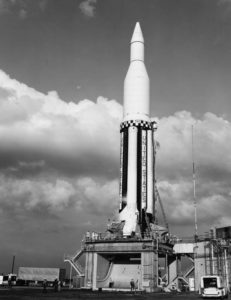On October 27th, 1961, the first Saturn booster, SA-1 lifted off from Cape Canaveral Air Force Station Launch Complex 34 on a 15 minute sub-orbital flight to test the booster. This first flight beget a series of 10 Saturn 1 test flights, 9 Saturn 1B flights, and 13 Saturn V flights.

Saturn 1 was a booster originally designed to support the United States Army. It was built using components, mostly engine designs and tankage, from the already existing Redstone and Jupiter missiles. the 8 H-1 engines used on the booster gave it a total of 1.5 million pounds of thrust, far surpassing any single launch vehicle flying at that time. It was developed by the team lead by the legendary Wernher Von Braun, and in many ways was the ultimate evolution of the technology his team had developed for the V-2 during World War 2.

It’s a long, complicated story of how the booster went from a US Army project to that of NASA and the Apollo program, but in the end, by October 27th of 1961, the first booster was ready to fly, and fly it did, reaching an altitude of 136.5 kilometers in altitude and 345.7 kilometers distance downrange, with the biggest issue to the flight being a shutdown just over a second early due to slightly less fuel and more oxidizer than planned being loaded into the vehicle. The booster was estimated to only have a 75 percent chance of lifting off and only a 30 percent chance of actually completing its mission.
Enjoy this footage of this first launch of Saturn. I don’t have much to say, the video does a better job showing the power of this rocket than any words I can put down. As always, relax and enjoy!
https://www.youtube.com/watch?v=Q-8c2VGnia8
https://en.wikipedia.org/wiki/Saturn_I
https://en.wikipedia.org/wiki/Saturn_I_SA-1
